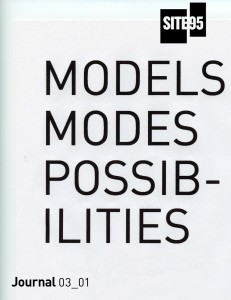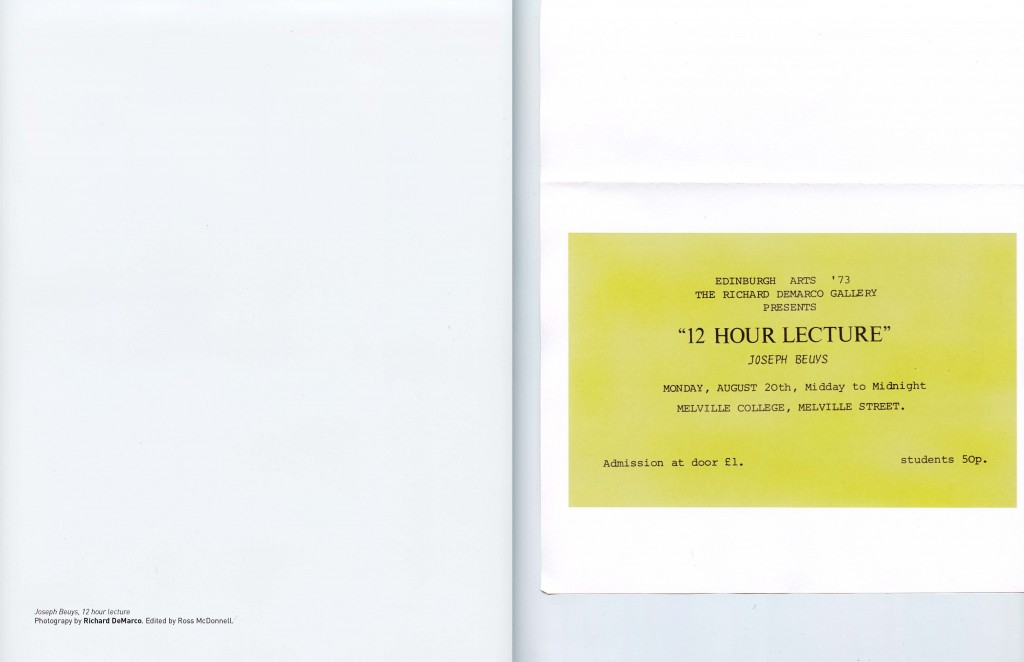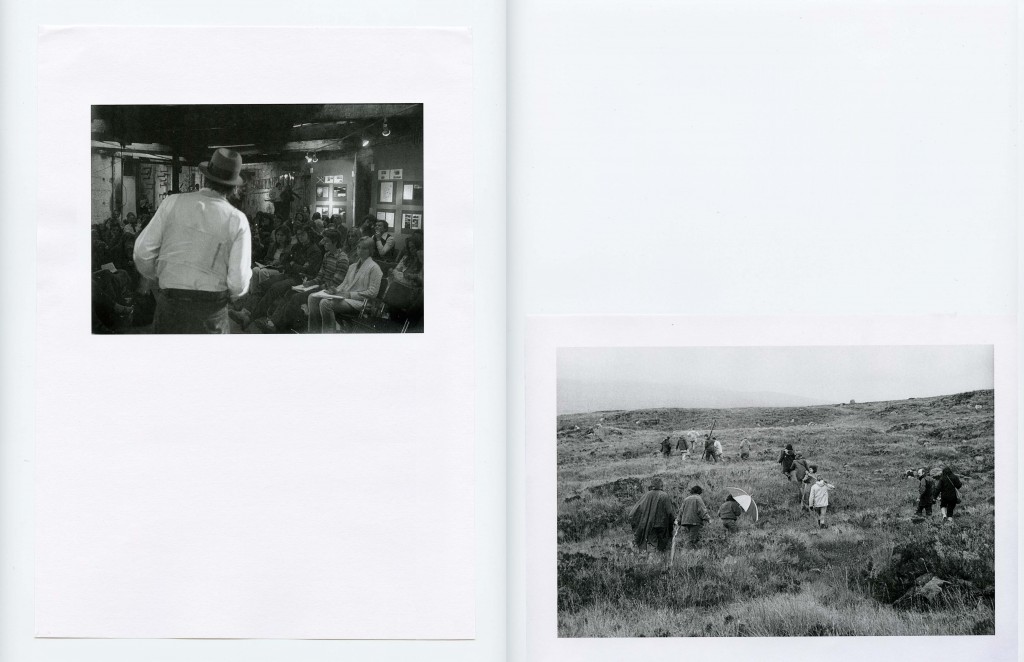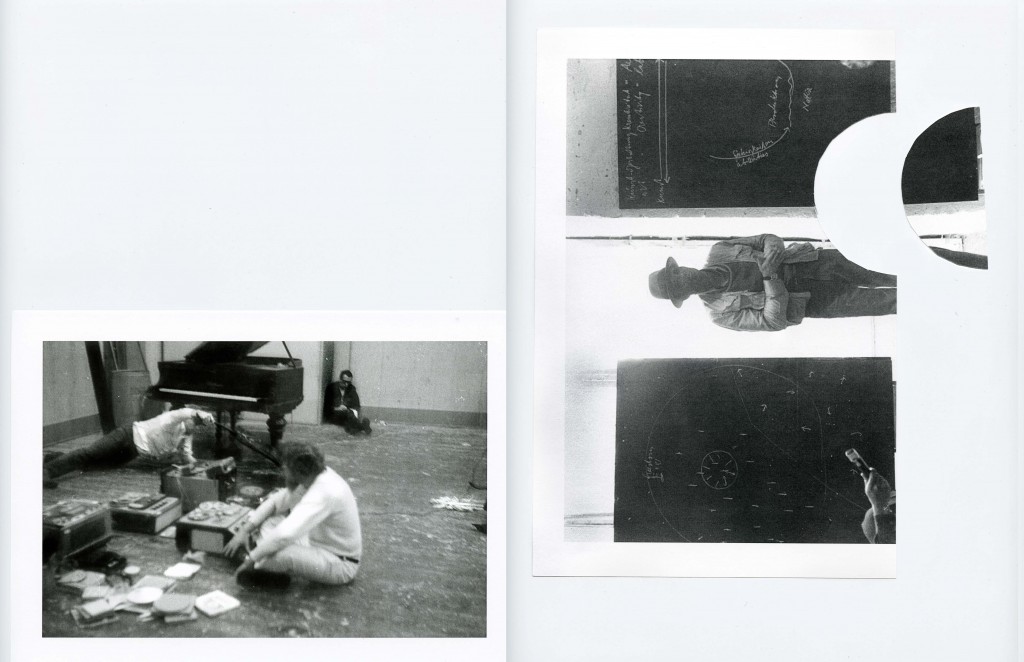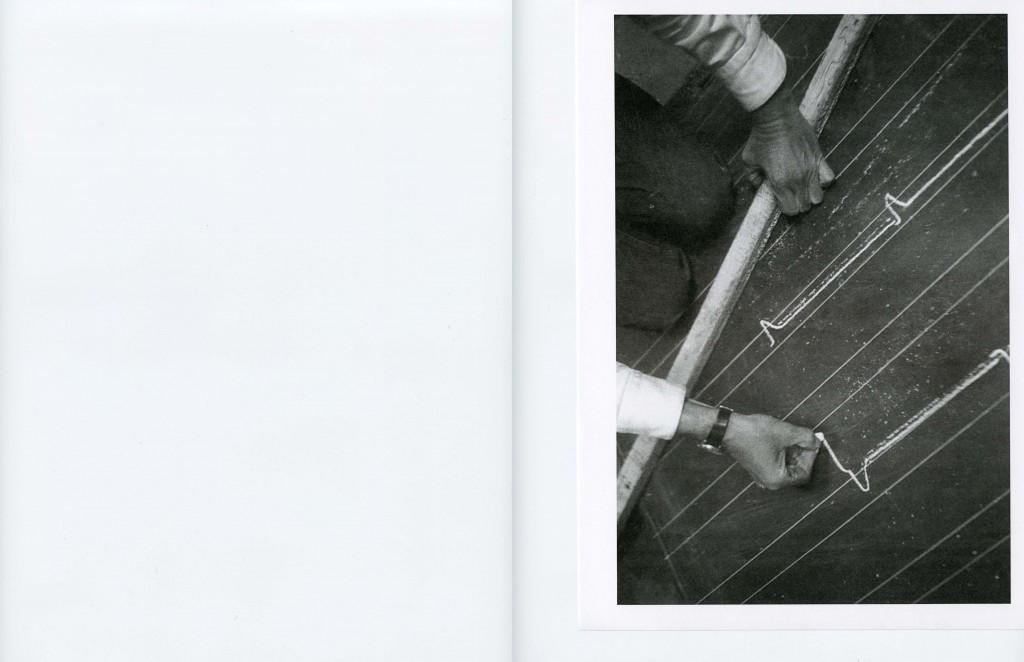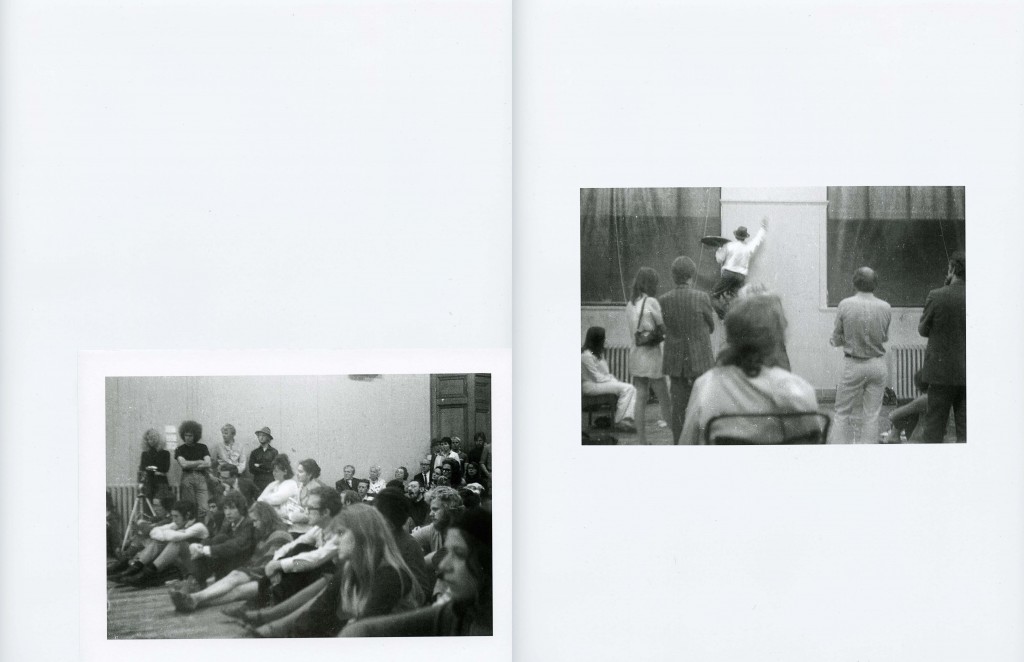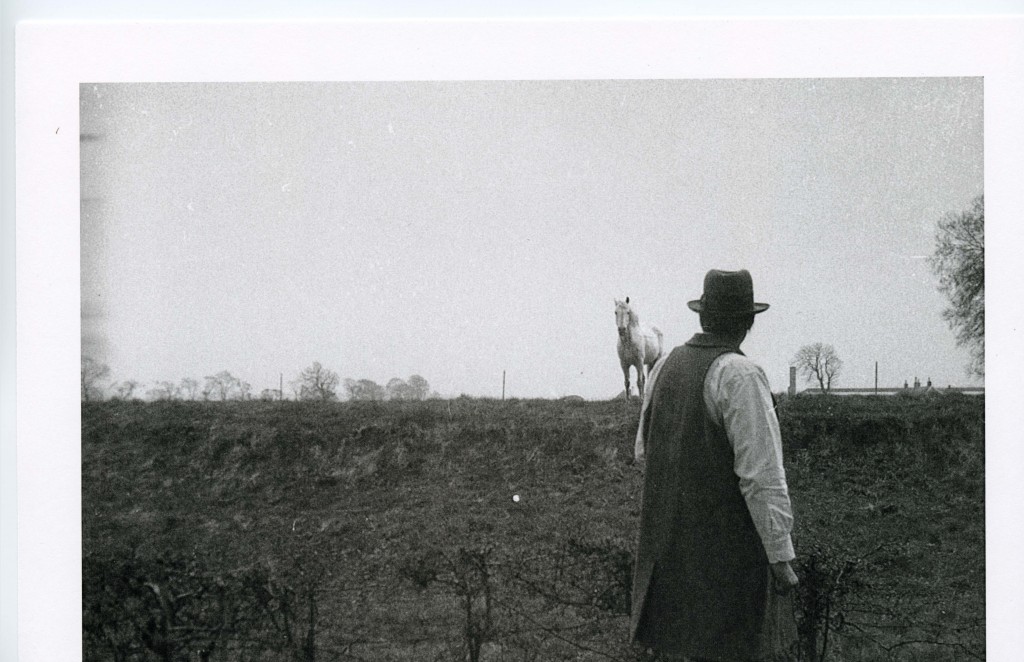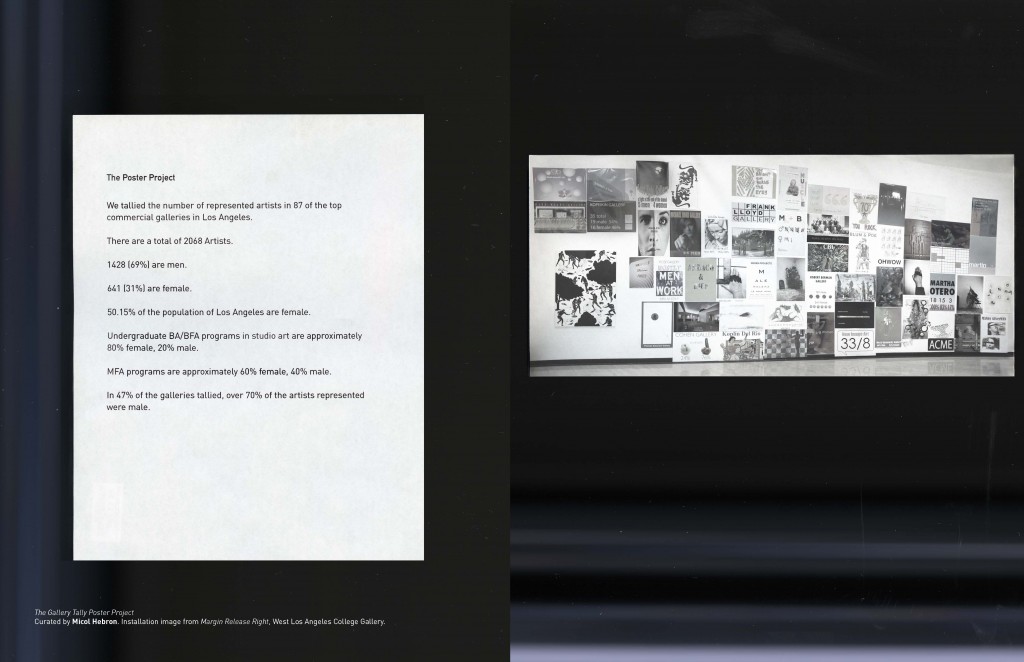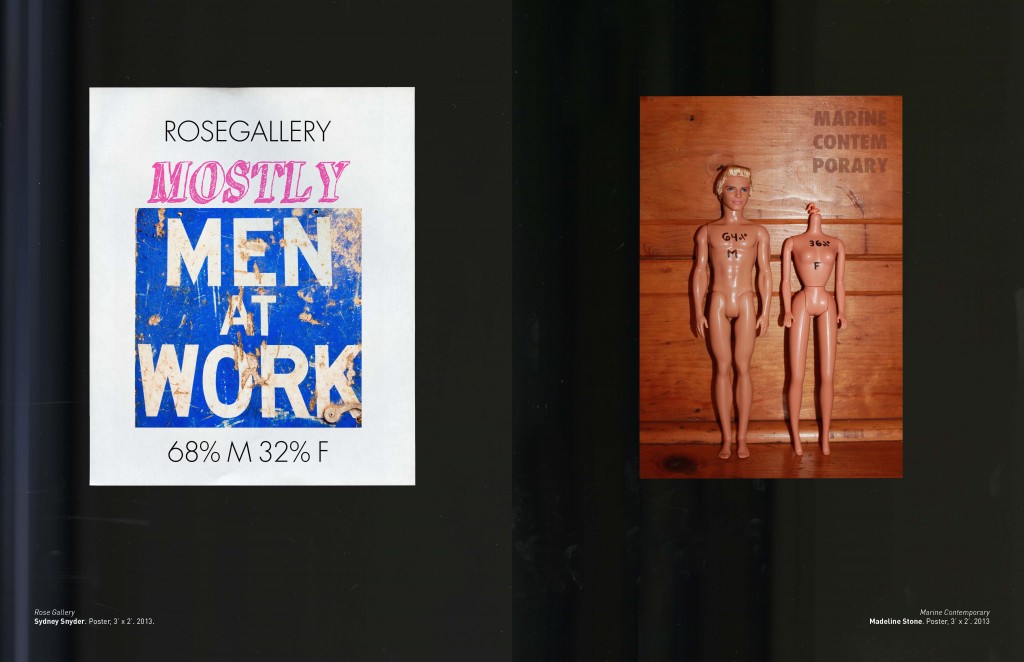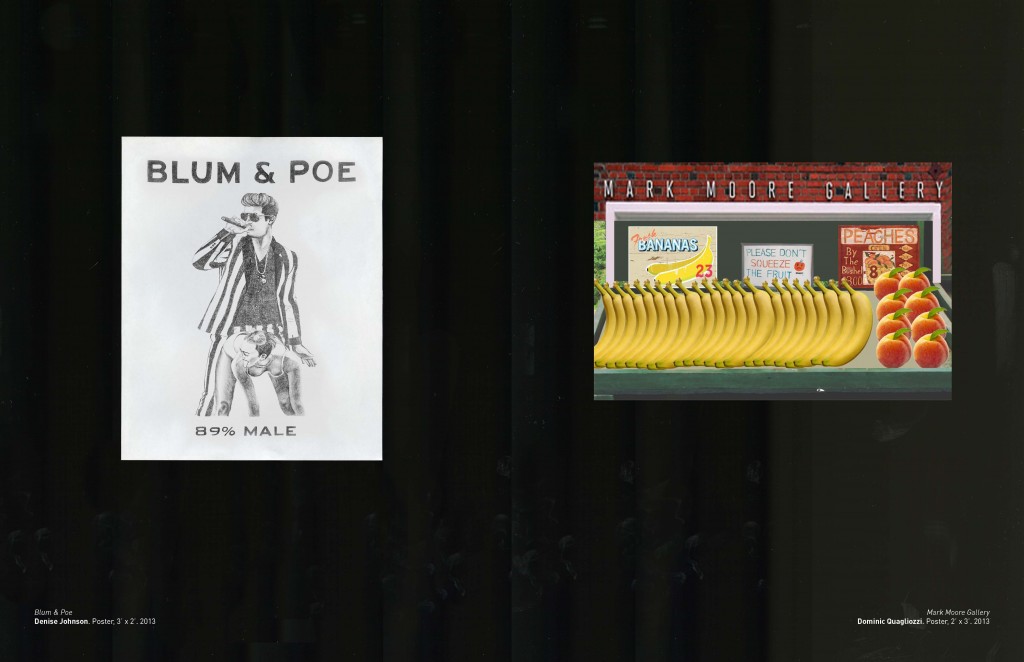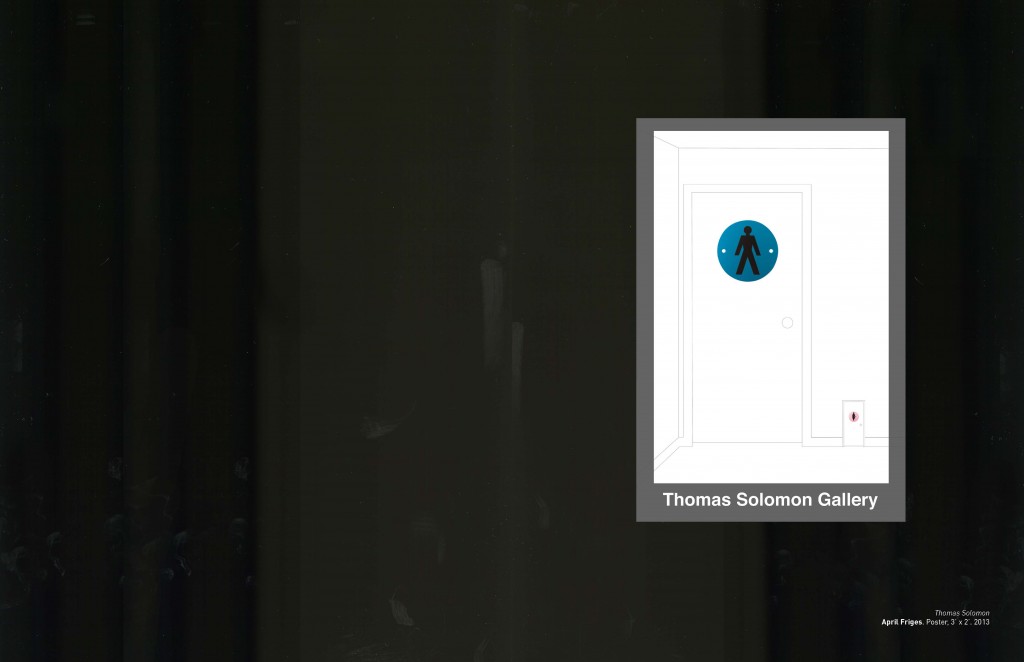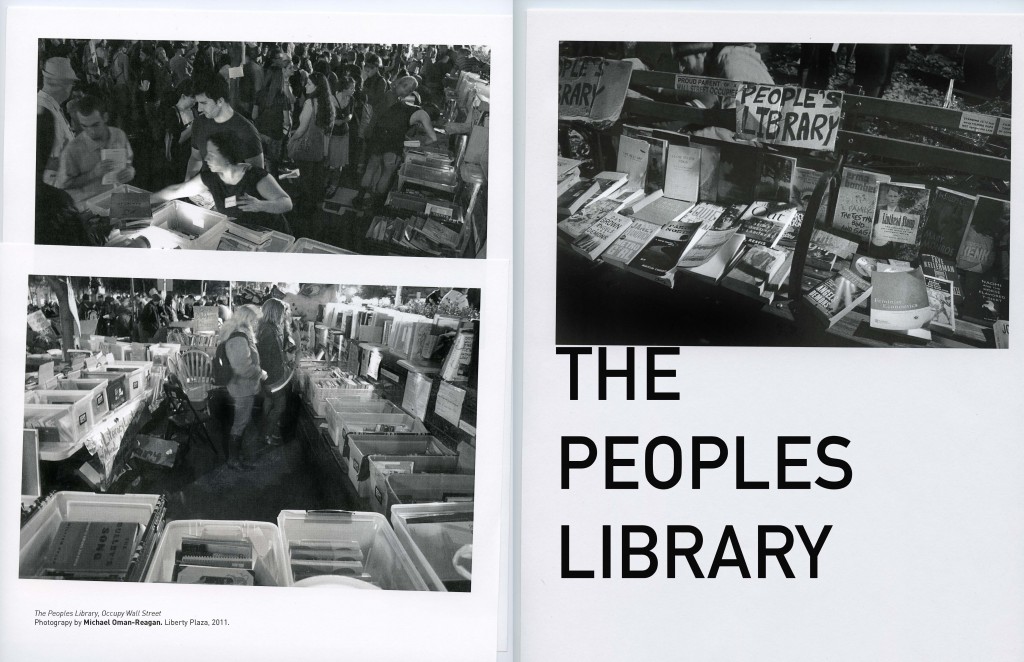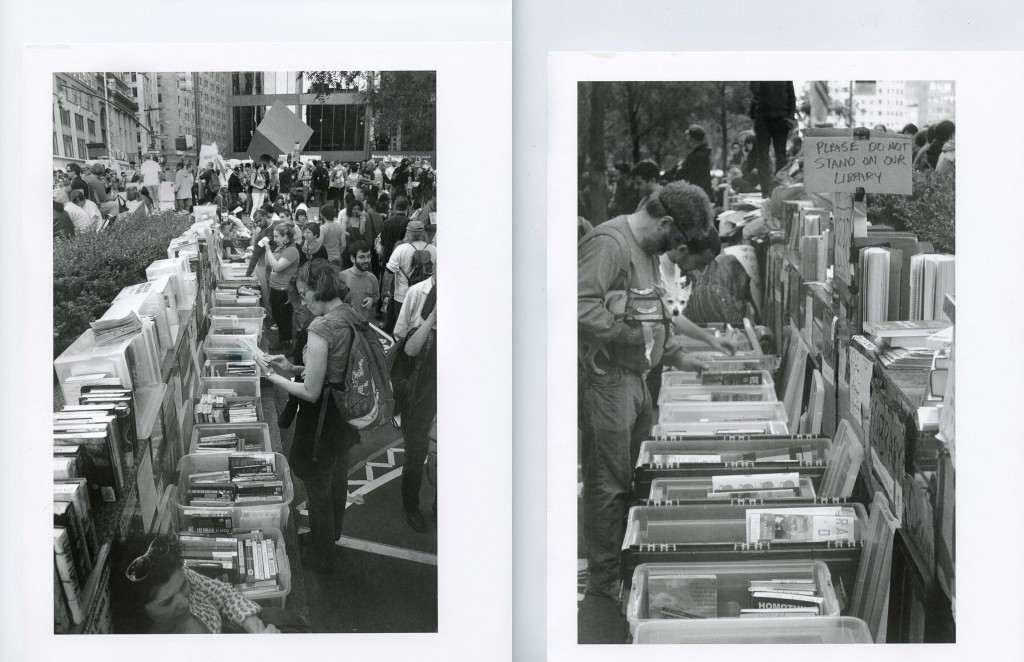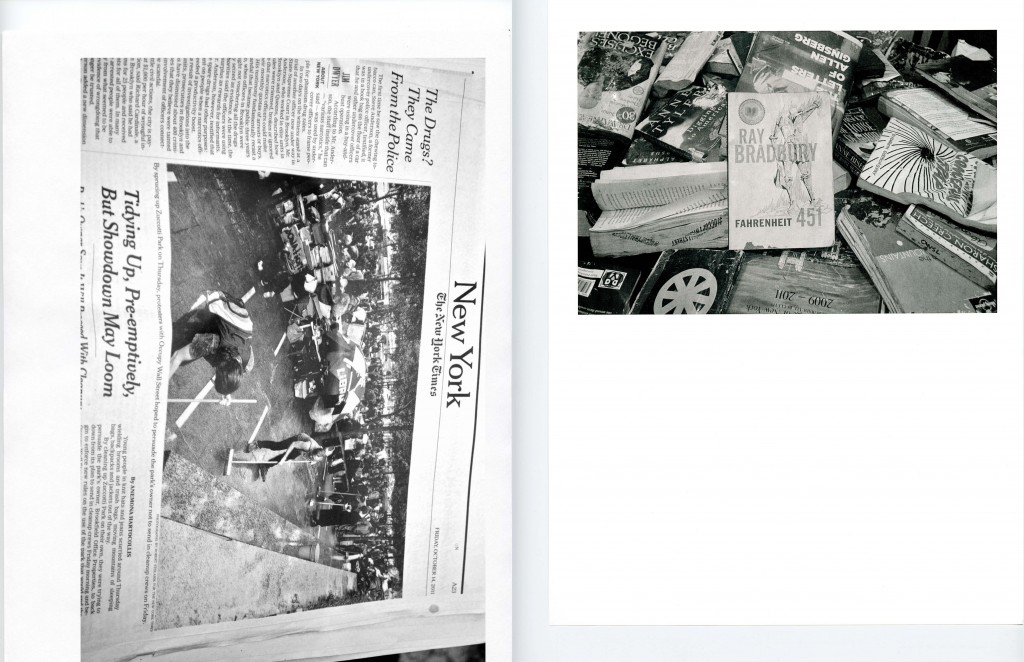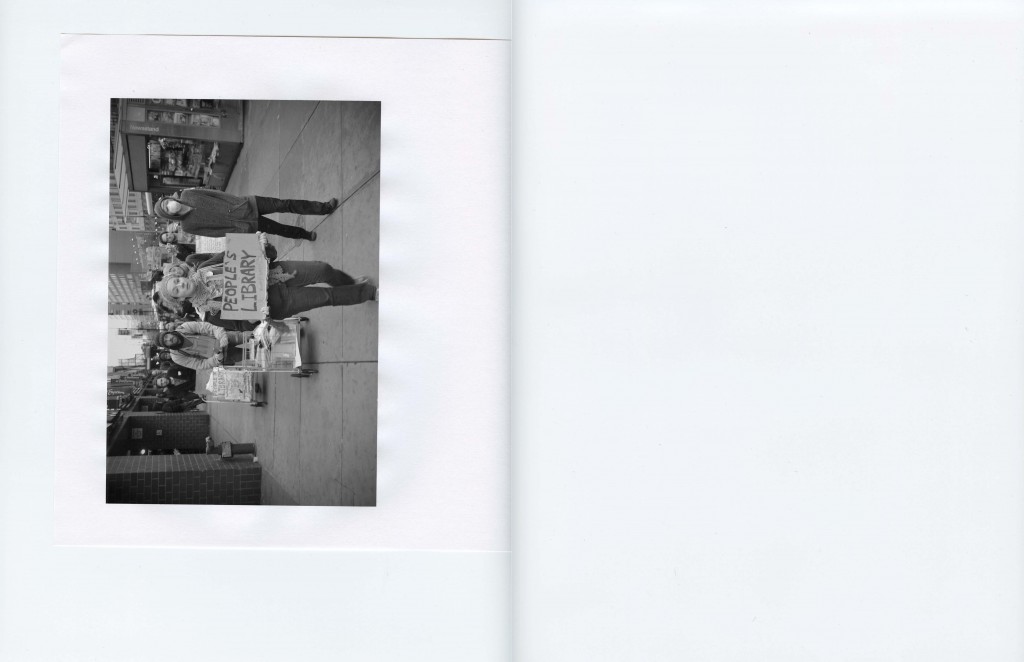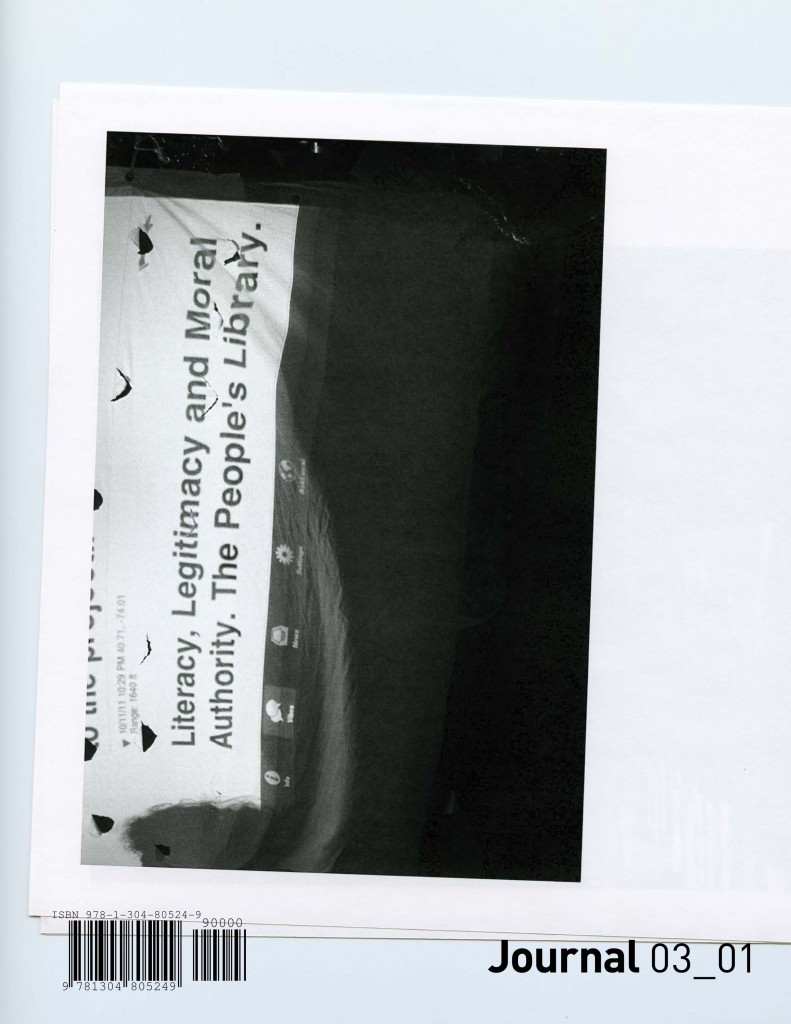03 01
03_01
DOWNLOAD PDF: SITE 95 ISSUE 03_01
Editor in Chief Meaghan Kent, Contributing Editor Janet Kim, Copy Editor Beth Maycumber
Organized by Ross McDonnell
Featuring: Ross McDonnell, Emmy Catedral, Anthony Huberman, Daniel Bozhkov, Nicolas Bourriaud, Simon Critchley, David Levi Strauss, Micol Hebron, The People’s Library, Michael Oman-Reagan, and Richard DeMarco.
Journal designed by Ross McDonnell, Logo designed by Fulano
Joseph Beuys, 72 Hour Lecture, Photography by Richard DeMarco, Edited by Ross McDonnell
3.14.14 models, modes, possibilities, and then there is education
Q Audience Question
AH
The title for this panel was purposely kept a little bit vague: “models, modes, possibilities, and then there is education.” It was kept vague, I think, because the hope is that with such an illustrious group of people here we would be able to discuss more abstract ideas, rather than a series of presentations that list the various projects or exhibitions that each panelist has done in the past. So with that in mind, Daniel and I thought of setting up the conversation with two starting points. On one hand, we would like to talk about the current position of the art school, or, perhaps more generally, the art institutions. To discuss some ideas about how to move forward from the status quo, to return institutions into the places for risk and for experimentation that they were in the past, especially in universities and schools, and that of course we all hope that they can stay and be in the future. On the other hand, we would like to talk about the current position of the artist and the public intellectual, and discuss some ideas on how to challenge or question what that role has become – to think about what it could be. One other way to phrase this is with another grand abstract statement that comes from a text that Carolyn Christov-Bakargiev wrote to announce dOCUMENTA (13). Her text asks the very basic question that we are trying to ask today: a problem we both need to consider carefully today is how to proceed as artists, makers of culture and intellectuals in the emerging economy and hegemony based on the exchange of knowledge products.
DB
Since the room is full of artists, it seems best to begin by talking about artists. I would like to open with some questions about the role of the artist, or how artists are behaving today. I’ll give an example of something I experienced. Almost like a light happened in my mind when I heard Tony Conrad once speaking about how his main ambition as an artist in the sixties was to maintain the useful incoherence in John Cage’s work. It really made sense to me. I didn’t live in the sixties. I read about the cultural situation but I imagine how, at some point, that extremely uneasy sort of practice slowly started closing down and started turning into some kind of a quest for Zen rules, a quest for chance or something. It reduced and kind of shrunk. And then something I read of Simon Critchley’s, who writes books about the art world and about art and artists. He said that: the ultimate demand is that art can be such a condition so that those things that do not exist might be brought about. Those two things really kind of came together in my mind. I was thinking about how – back to thinking about Tony Conrad – if we now have this term of knowledge producer and artists being the kind of end of that – or maybe before the end of that, of how in Tony Conrad’s case he was positioning himself as a knowledge un-producer in a way. Somebody who is actually reversing something “halting a flow”. Something quite specifically that way, something that is almost preventative. The question is: since artists today face the status quo, in a situation that Franco “Bifo” Berardi calls Semiocapitalism, where artists are the model for a standardized sort of cultural worker that is flexible, always available, always working, always providing content – first of all, is this a position they actually tend to have and have to obey? Or is it a forced acknowledgement that there is still no way out of that? Or can one imagine other models? Other sort of misbehaviors, other instances that we now think about, where that program is not actually completely fulfilled? I propose that question to the three panelists, but maybe Simon would like to take first response.
SC
Good question. I wish I knew the answer. In relation to knowledge, there is a thought that there has been a kind of informalization of work.The distinction between work and non-work is increasingly porous and increasingly hard to maintain. The artist becomes the exemplary worker in a situation where the distinction between work and non-work is increasingly hard to maintain, and in a sense, the emphasis is upon flexibility, creativity, and adaptability, “always on, always being at work”, right? See, one way of thinking about this is that the model of the exemplary worker has become the artist, and the artist has become the exemplary worker in some strange way. That leads to a certain set of questions about what one does with that – the economy, capitalism, whatever. There is a sense in which, with the collapse of the idea of the artist as autonomous, separate, distinct, there is a risk of the artist as utterly complicit, which then raises the question of critique and all the rest. You know, I think the question for me – which has also to do with what we are talking about, education and institution, and this is very important for me fromwhere I sit – is that the task of the artist or, indeed, the philosopher is not to produce knowledge, not to be involved in a system that produces knowledge. In a sense the University is a kind of machine, a machine that stands for the production of knowledge and expertise. It’s that which has to be criticized. That which has to be stalled, that which has to be idled. I mean the thing that I found very interesting to go back to in the last couple of years is Georges Bataille. Bataille had this idea of knowledge as a kind of system, an idea of what he called sovereignty, which would be the intent to open a space that was denied within that system. The formula for sovereignty was something like: impossible, but there is. At any point where one looks today, everyone could be implicated in a system that saturates, drains, renders us complicit, and all the rest. Yet, it seems to me that there is still the possibility to go back to the title of this session, a possibility of something that would idle, or stall, or mess up that system. That would be kind of sovereign in relationship to it. And to risk this as a first proposition – not that I have any idea what I am going to say in the next thirty seconds – but you can say that in the face of a knowledge-producing society, the task of the artist is to puncture holes in that – to puncture holes in the self-certainty of that system in the name of, to call to use a certain term, truth. In the name of – [baby noise from audience] – Hi there! A young artist! Truth! Yes! And truth as something that one has a relationship of enjoyment to. That’s one way of kicking things off. I come from Britain, which has come from a kind of awful middle-management bureaucratization of the university system, the art school system, well, everything else. Where, you know? It’s incredibly hard. There is a real lack of imagination at the level of what an institution means to be and what an institution might be. That’s one of the things that is very much in my mind. What are the institutional, collaborative forms of thinking, forms of activity? It seems that to that extent, the question of how to proceed, which was raised before, I think that the discipline of – I see it as a discipline – of, let’s say, for want of a better word, those on the left, is to always ignore questions of the future. Right? Questions of the future are always ideological. Because the future always means some version of what is happening now but with better software. I think the discipline of the left as I see it is to refuse the question of the future with bio-cultivation and what’s radical in the past. So, we can look at this point, and this is also suggested in the questions that Ross and others were circulating – we could look at this point, at traditions – at different possibilities of institutions which existed: free schools, free schooling, all sorts of good stuff, within the traditions that harbored those. You know I was going to begin in this way, but I didn’t. I was going to begin with a witty remark, which was – Freud writes this to Princess Marie Bonaparte in 1937: Was will das Weib? What does a woman want? And I was going to ask the question: Was will das studenten? What do students want? In a sense, we’re irrelevant, or at least I’m irrelevant, because the system I was educated within has disappeared. The situation of the student now is much more serious, and defined overwhelmingly by the experience of debt. I owe, therefore I am, as it were, right? And what does that – what is wanton at that level? What is being articulated? One of the things that was fascinating for people like, for old fuckers like me, in Occupy Wall Street and different things like that was that you saw the possibility of different forms of institutional space. You saw the general assemblies or media groups, you saw people behave informally and the consequences of that, like the Free Universities in Madison Park, and things like that. Now, one can always ridicule those things and say they failed, but I think that what it means to be a student at this point within this, as it were, system, this system of indebtedness, where one’s identity is borrowed and I think, will be perpetually in debt. That kind of raises to me in a more radical way the question of institution.
AH
I think we have a great advantage today, here, in having a room full of –
SC
People in debt!
AH
Actually no, Hunter has a public school-aspect advantage, so there is a little bit less debt. But it is also a room full of artists who are not of our generation. We are going to go back to these questions about the institutions, and how structures and models of organization that come about via what people actually want. To try to stick with the artists, to try to stay for a moment and hear from the other two panelists before moving onto the institution, how does the artist fit in to this? If the artist is this Semiocapitalist, the effective worker at this point, one who has to heed to the infinite demand of the marketplace, who is effectively the content provider of culture, where does that leave students and what can be done with that?
DLS
Just before coming here I heard these figures. Apple, Amazon, Facebook and Google –four giant corporations—currently have over a trillion dollars in market capitalization. But, all together, they hire only one hundred and fifty thousand people. That’s less than the number of people that enter the workforce every month. So very soon, I think, the whole idea of what work is and what a job is, is going to have to change. And to me, that means the idea of leisure will change. Art and literature – what I am interested in – requires leisure. Things are shifting very rapidly. I like this idea that the artist is the ideal worker who is always on, always asking questions, always producing, but it brings up a lot of questions about what is meant when you talk about the complicity of the artist. The poet Susan Howe said that the history of America is complicity battling redemption. America has always gone back and forth between these two. I mean all these questions were active for a long time. I think I am the oldest panelist here. I lived through the sixties. I was fifteen in ‘68. I remember some of it. A lot of these questions were active then. One thing that I find now is that people tend to look at recent models, and it’s always been more useful to me to look at distant models and try to bring them into the changed conditions that we live in. Otherwise, you end up repeating yourselves every five or ten years. Which is, I think, a problem with art schools and artists in art schools.
NB
I just picked up a few of the words as we started our discussion – the idea of the artist as producer of knowledge and the artist as refusing to look into to the future. It reminds me of course, it’s very obvious, the very short text that Walter Benjamin has written – a philosophical history with the Angelus Novus, Paul Klee’s drawing – about looking backwards and accumulating wreckage, accumulating itself under his feet, actually. This wreckage is actually what we are, in a way, living in. This huge accumulation of information – it is exactly the landscape of our practical and theoretical thoughts in our everyday lives, also. What is pretty specific to our time, I think, is the fact that no one can master knowledge any more. However, they can produce it. It is still possible to produce knowledge. There is inflation of information, and that would bring us to Bataille, as you say, Simon. But I would rather speak about this very interesting notion, which was that he created this kind of new science, which was the science of wreckage of debris called heterology. Heterology is the science of what can be created. In a way, we are talking about art here. What is this strange stuff, this material that we are talking about which is not fully activated? That’s where Bataille is brave with regard to writing today because we are talking about something that doesn’t go into the flow of production, which cannot be fully integrated in the fluxus today. There is a mathematical sign for it. It is omega, as far as I remember, omega being infinite plus one, you know? Infinite plus one. It is the sum of all numbers plus one. And that is also a pretty good definition of art actually, interestingly. I never found a better one. It’s this plus one, which makes it difficult to assimilate.
AH
Because it always exceeds the conditions that accumulate?
NB
Yes, this idea of excess. I think that is for me very Bataillian. We can come back to the idea of being in an art school in a way, from here, which might be a good way to recuperate the original pattern of our discussion. But I think today, as a director of an art school, the idea is to turn it into something slightly different then it has been, actually. The Beaux Arts School of Paris is a place that actually has a really incredible exhibition space, which was not really fully used until now. And the idea will be to build the school around the art center, to wrap the art center, but I can talk about this when we can get round to it; it is maybe an institutional aspect.
AH
That bridge to the institutional, to the art school, is interesting. It’s interesting this connection to Bataille, and I think everyone mentioned not only excess, but also this relationship to pleasure, and this relationship to leisure, as David said. That there is something that is always in excess of knowledge when we talk about pleasure, about exhilaration, about exuberance. There is always something that exceeds knowledge, that exceeds knowledge production. It seems, therefore, that maybe an art school might be a place where that exhilaration could be a little bit less instrumentalized or domesticated. Art school is such an important, interesting and relevant thing to pursue. The history, whether it is Black Mountain College or all sorts of different examples that we can talk about, is that it has been a place that is a safe place, safe from the culture of consensus. A place that is trying to be about let’s allow a context where people can take risks and rub other people the wrong way, and be inefficient and be ineffective. And so, the question is, if we want to make sure that an art school continues to be that way, what does that mean for us today? How can one organize a particular relationship with a teacher and student, or an infrastructure that is an art academy, in such a way? In the sixties, Black Mountain was organized in a particular way around withdrawal and retreat, and a co-mingling of disciplines. That was kind of the answer that seemed appropriate in that particular historical time. So, what now? Especially in a time where the art institutions of the world, museums, et cetera, have completely normalized institutionalism, the discursive turn and all of these things. Now we are at a point where you cannot organize a big show or a biennial and not have a super big and potent educational program, a research congress, and all of these knowledge productions. And at this point, that is the standard. That is what the big exhibitions are doing now. So, what does a place of risk look like today? I mean maybe Nicolas you want to start. I’m thinking about specifically what you want to build on at the Ecole des Beaux Arts and what you want to keep from what it is already?
NB
I think to try to answer the question we go back to the situation of knowledge, which is over production of information. It’s a totally new situation that we are living in. I think that knowledge today is not just accumulation that we used to know but something looking like navigation, in a way. How to get from one point to another? It would be wise to create lines of knowledge more than objects in a way. Use lines, paths.
SC
Maps…
NB
Maps, of course. So, how can you as students draw the territory of the people – shared territory – as something that might be worth living in? That is why I am circulating and producing a path more than anything else. So an art school should always be a place where you learn to organize paths. To collect. To build kind of a personal connectivity, I would say. Yes, that’s the first element, according to me. It is the relationship that we should establish in any school between production and navigation. It is also the relation to the past, which is to refer to history and memory, which is very important, yet at the same time, to remember to forget the past. But you have to face the past in exactly the way you enter history – by facing the future, in a way, backwards. That’s one of the reasons, I think, that this proximity to the artwork is the key. That is what I was talking about when I talked about organizing the art school around an art center. I think it’s the relationship of the artists to the artworks, which is absolutely essential and crucial for me today.
SC
You know, there is a very good quote by someone called Nicolas Bourriaud, which I brought with me. In large print, so I can read it. He says: the end of the discussion which begins most twentieth century art was conceived around two key notions: appropriation and documentation. We go through Duchamp, and there is a list of different movements, and he says that: with Fluxus, a new mode of production began to develop, one fueling the strongest contemporary art practices today. In these practices, the important bit for me, work ceases to be the record of a state of things but work becomes a matrix, a score, an object that generates other objects or attitudes, or platitudes. Art no longer presents a bygone event. Instead of constituting a fact to be noted, it produces future forms by provoking other events and inducing behaviors among the spectators. So, on that view, art is not, as it were, the production of something that was a fact, right? It is the establishment of a matrix, or a network that produces future forms, right? An event that allows other events to take place. That interests me greatly. I mean, what’s implicit with that, the way I hear it, is a shift in paradigm, if that is right, from questions of time in history to questions of space. In a sense, for me, it’s much more productive. Productive is the wrong word. Interesting, let’s say. Maybe that’s the wrong word. No, interesting is the wrong word. Much more…something. To think about activities, you know? Thinking – making in relationship to spatial organization rather than temporal organization. So, are we in a period of Post-Modernism, or Post-Post-Modernism? Or, there was Antiquity, and then there was the Renaissance and then Antiquity all over again. Then there was the Modern, and then there was Modernity, and whatever. In a sense, yes, of course. But, no! Right? If we think about elements of the past as giving maps or matrixes, which allow future forms to be articulated, then I think that is more interesting. If we think about, say, my area, which is philosophy and literature and things like that – spatially rather than temporally, it means we can take Aeschylus’ Oresteia and put it up against Cervantes and up against, you know, a bit of J.G. Ballard or something, and we can begin to construct something that might make something happen. I think that’s one model, which is kind of a temporal spatial geographical model that I find quite interesting.
AH
Is it kind of building the motor to push the car?
SC
Yes. I don’t know. Is that? What does that mean?
AH
Well it just means that – okay, it’s a terrible metaphor – but it’s about putting something in place that is igniting something, right? Like an engine versus an object.
SC
Yes, an engine that stalls. An engine that breaks down. An engine that doesn’t work particularly well. An engine that ceases to be an engine at a certain point. A sort of crap engine. I think the most difficult thing to think about at this point for all of us in all areas of what we do, is activities and relations that are not reducible to utility. Not reducible to some sort of straightforward use function, or some sort of service function. And, this is where the question of, say, pleasure or enjoyment is incredibly hard. Is pleasure for us to become a model of utility? Is it something you do in order to…? This is most obviously the case in a sexual activity, right? In its crudest form? What would pleasure or enjoy- ment be that wouldn’t be reducible to that utility? And to say the word pleasure is a kind of dirty word. It is interesting that it’s something that you shouldn’t do. You should be doing this for some purpose, right?
NB
We find Bataille again. When you said space and time are, you know, where time turns into a space. Isn’t that the exact point that we are talking about? I tend to think that the characteristics of space and time are actually at the moment intertwined. Space is only something that’s the product of accumulation. Things get accumulated in space. In time, things tend to succeed one to another. The thing is, as the world becomes kind of a huge archive, and nothing disappears anymore, everything is accumulating. And time is accumulating more than space, which actually tends to get immaterialized more and more. Time and space are kind of exchanging properties. That’s a crucial point. I remember this very interesting text by the American art historian George Kubler, which I really think is remarkable, a very important influence to Robert Smithson and his generation of artists. He was saying that actuality, if I remember well, could be compared as the dark between two flashes of a lighthouse, or the interval between the ticking of a clock. Something that we cannot seize, but we know that it actually exists. It’s the surface where all the signals coming from old times are actually crashing. That’s the present. And the present that we are living in is an accumulation of signals coming from different periods of time. And more and more visible because we keep them alive much more than any other civilization since the beginning of time. All of the signals are kept alive and the landscape is totally fragmentary now. So we have this huge mass of signals coming from very different space times, which are part of our everyday, kept alive by all the technological means that we know. This is the new situation. We are living in a constellation in a way. If you look at the stars, some of them actually are dead for thousands and thousands of years. You are looking at some past, thinking it’s the present. And that’s, I think, a good image of the artistic landscape we are living in. It’s this space that is not a real space. It’s time mixed to space, I would say.
DLS
You know, I don’t know why Bataille has become the tutelary daimon here, but I always go back to the Bataille that was trying to find the beginning –
SC
The cave paintings of Lascaux?
DLS
Yes, which I just taught about recently. It made me think about – well, whenever I think about artists, I think of artists and writers. I think of the two of them together, I always have. I think good things happen when artists and writers get together. They basically face the same problems. On the way to this, I was walking with a friend of mine and talking about my instances, my models – the educational models going all the way back. And he noted that every one of them has to do with danger and censorship. Every educational position that I have ever been in has ended up with some kind of censorship or some kind of censure requiring rebellion. So, I think that that’s not just me. That’s built into the very nature of education with artists and writers and I would like to try to figure out some way to get back to that. But it also made me think – I grew up in a working class family in Kansas and when I first went to school and first started to read, I imme- diately became a voracious reader. And I always felt that this was illicit. That somebody was going to stop me, because there was something really wrong with it. It felt dangerous. My father got it, and he tried to stop me from reading. Because he understood what it meant. It meant that I was no longer subject to the authority, to the educational authorities around me. That I could go anywhere, I could do anything, I could be anybody. And it was dangerous, and they should have stopped me. That remains with me now. It shakes the foundations; it introduces all of these uncertainties that are, by nature, dangerous. It’s dangerous to change your life. And I think all of us that work in education, that’s what we are trying to get to. How to build the structure for that is the question.
AH
I think the question essentially is: how could we insert danger into the situation that Nicolas describes? And going back to what Simon said about the artist today needing to puncture holes in the fabric of the real, in the name of truth and pleasure, the role of the artist or student is to not produce knowledge but to somehow take the way things are to the way that I think Nicolas described very well, that way in which time and space have kind of swapped places. As an arts school, how can we create a place where we can allow artists to feel like they make that condition there somehow? How can we nurture danger within that reality?
NB
I tend to think that information is translatable. Knowledge is not. There is always something missing between the translation of sheer knowledge and that element that you cannot translate. It is exactly what you are talking about. It’s still this idea of iteration of something that remains; that will remain. It’s very difficult to handle. And that’s also one of the functions of the art school – any teaching in way. It is this infinite dialogue that we are talking about. It’s the idea that Marcel Duchamp had about the artwork as a producer of commentaries. It’s a very timely idea in a way that the text has to be commentated to become real knowledge. That is the same for any image, any form. It’s schemata, as opposed to law. It’s in this field you might find some indications about what is different between knowledge and communication.
DB
Yes. And danger, it’s one of the actual clear signs that suddenly the language is working on a different level, where that the free flow of signifiers is interrupted or somewhat, disturbed. It’s interesting what you’re saying about the translation of art. Because I myself can register a bilingual experience. I know you, in your work, Nicolas, that you deal with translation a lot – that specific type of translation. For me, it is something like the word “apple” and the Bulgarian word “ябълка” – which are the two abstract words for “apple” in Bulgarian and English, which are two completely different objects. The rudimentary experience that I have of those two are actually completely different. So I think that the knowledge is there as two completely different situations.
AH
I mean, musical metaphors could maybe describe that situation, right? The difference between knowledge and information, and the difference between written notes on a score and one that is played by a particular person with a particular instrument with a particular mood and aspect and attention – and that translation of how the written note or written word turns into something else – is that kind of the way that you’re describing the difference between an information object and a known object? It relates again to what Simon was saying about these schools as matrixes, as these places that essentially exist as machines to enact translations.
SC
Yeah, it’s a question of the institution. My discipline, Philosophy, has always been a school discipline, right? We invented the Academy. And what was the Academy? A kind of informal network of people outside the system engaged in conversation. We don’t know what happened, but we have seen texts written about it, which gives an indication of what happened. Often, it’s one person who claims to know, being questioned by someone who doesn’t claim to know. Socrates, who shows the person who claims to know, doesn’t know what they think they know. And then, when it’s been made clear they don’t know what they think they know, something else begins to take place – which we can call education. So education, in a sense, takes place when there is a suspension of that certainty about knowledge. We find nothing gives us greater anxiety than that. I mean, the strange thing about human beings is their desire for a determination of behav- ior. This is our love affair with the brain, right? Our love affair with neuroscience; our love affair with… whatever. And it’s always been the same, right? In the nineteenth century, they believed in phrenology and now we have got neuroscientists. We want determi- nation because it stops us thinking. The first task of, as it were, philosophy, is to suspend that mode, to interrupt that. In the name of dialogue, in the name of something else. What’s the institutional setting for that? Well, I like the idea of institutions which are informal and which are at a certain distance from the city. That’s what Black Mountain College is – and I’m not sure about that, I don’t know enough about that – but there is a seduction to questions of retreat and succession. I was in Vermont for Thanksgiving with my friend, and we were fantasizing about designing an institution in this weird village that we found, but we couldn’t work out how to raise money to do it, so it didn’t last long as an idea but it would have been nice, you know? You could have gotten a bunch of people there, we could read books and talk about things. But the idea of institutions as formal structures is the translation of the institution into the model of university, which really happened in the early nineteenth century. It’s very recent, the idea of a university- a pyramidal structure with an administrative cell or a head or rector, and then professors with their assistants and whatever. That model that was brought into France by Victor Cousin and people like that- it still determines the way we think of a university. That is a very bad way of organizing education, it seems to me, because of its verticality and all the rest. I think there are tons of ways of thinking about different institutions and tons of lessons to be learned, and maybe the more distant ones are more powerful, as David said. They don’t last forever and they shouldn’t last forever. A difficult thing about institutions is letting them die, as well. And there are certain moments where something happens – and then it’s clearly not happening, so let something else happen. It’s very difficult to give up. You can do something interesting for a period of three years or five years, and then it’s over. Now, it’s in the interest of a university and in the interest of those with jobs and in the interest of the administration to keep the thing going, to ring the very last dollar out of that machine, so we find ourselves in a kind of institutionally impoverished mode. And is the art school a symptom of that? I don’t know, however, you may question that. When I do things up at Columbia – I did for a few years – you realize that the people sitting around the room have paid however much they have paid to be at Columbia. And then you ask the question: well what do you want from this? You want to pay back this enormous debt that you accumulated in the name of what? Celebrity, fame, stardom, glory?
AH
You can no longer afford, literally, to de-instrumentalize your time… you have to have to be efficient and effective…
SC
Some might object to what we are saying, that this is a kind of luxury position, that we are not really facing up to the harsh realities of the present life. Risk… risk. Yeah, I don’t know. The problem with all these things is everything can become ideologized. Risk is one of those terms. You know, we have an idea of a risk society and then we can open up whatever in-flight magazine and it will be about risk. I remember fifteen years ago we used to say things about – well, I used to be a great follower of Jacques Derrida, and Jacques Derrida used to say things like, it’s all about negotiation. Negotiation. This is in 1985. Then five years later you got magazine articles on Negotiation. How did that happen? Everything can become ideologized and complicit. So the term we use – danger, is another one, right? There is an acceptance of the short lived nature of institutions, their informal character, their ability to live at the edges of other institutions and to have a fleeting, beautiful existence.
AH
One way might be to inject temporality and fragility within an institutional structure and to inject distance and withdrawal into institutional context. I wonder if any of you would want to add to that or change that? I guess specifically, we are speaking to two people who run programs in major urban centers, in New York City and Paris. How, within that context, do you feel you can speak to this idea of trying to challenge the way that this thing that is teaching, has been organized? How we can make it into something that feels like it is more true to being able to actually, as Simon said, challenge that addiction to certainty of information?
DLS
The only way it has worked for me is to have somebody give me a blank check, and that’s what it takes. It takes somebody saying “you do it.” If it works, it works. If it fails, it fails. It’s all up to you. And that doesn’t come along very often, but when it does, you have to seize it. I mean there are things starting all the time. You don’t have to go with the institutions that exist. You can start new ones. And they start sometimes very organically. I was thinking about the People’s Library at Occupy Wall Street and how it grew, and I became very, very close to it. And it was just…I mean, it was a bunch of people staying in the park. They had time on their hands. Many of them had heavy student debt. Somebody thought, maybe we should continue our education here. That’s how it started. And books started coming in, and people started reading them, and they started going in and out and it turned into this really great thing. I mean it worked. Until it was crushed. It didn’t fail. It was crushed. Bloomberg came in and crushed it on November 15th, 2011, and destroyed the books. But during the time that it lasted, it was a magnificent thing. I mean people will accuse me of idealizing it, but it really worked. It was what a library was supposed to be. I mean you take a book, and if you want to keep it, you keep it. You bring some other books in. It worked.
NB
I like the idea that is super simple, but very true, which is: when it works, it works. It reminds me of a coefficient in any art school. First, how many in one year, in one generation or grade, will really become artists, and then international artists? It is, according to the statistics, let’s start with very, very simple facts, between ten to twenty percent will become artists. So what about the other ones? I think we should start thinking about all the people who are actually studying in art schools and do not become artists because it is something which is not thought about often, and I think it is absolutely crucial. It’s like having a school for pilots and to have only ten percent of them who will become cosmonauts. It should be, I think, a very real project for art schools to become more conscious of the future. The way people are taught and trained in art can integrate in a broader landscape. There was a fantastic British artist in the sixties called John Latham, who did this very interesting project called Artists Placement Group. His idea was to have artists at any level of society, within any position-making group, everywhere, at every level of society. I think it is a very interesting, visionary way of thinking. Maybe art communication is not only for the art world, maybe it’s also much bigger. That’s something nobody dares to say, strangely enough. Really, it’s crucial.
AH
Building on this idea of temporary, fragile nature and this idea of being rich enough to have autonomy… also, I think, it’s a really interesting point to think about how to de-intrumentalize art schools and teaching, in the sense of not only going towards furthering and building on a career in art but somehow allowing the schools to be useless in regards to art, and useful in something completely different. I just want to ask one of the questions to Daniel, as I want to make sure that the voice of the artist is in this as well. Another thing that I think is important is how the teaching is done and the idea that artists think differently about how to go about teaching. Does this idea of teaching as particular practice that some artists have taken on, does that idea have any legs with regards to this conversation? Is that another way of artists thinking what it is that they want to be as teachers, and how they conceive of themselves, and completely ignore the line between? I am an artist and I am a teacher. It’s having it be essentially part of their work. But what does that mean?
DB
I am very interested in that level of things. Because for me, it relates to two very important things I care most about. One of them is: does art have anything to teach the world? In a very grand, abstract way, but also quite particular when it comes to specific ideas. And the other thing is more like that Beuysian moment, the way he declared that his greatest work of art is teaching. Maybe he is completely right about that, the fact that none of the other specific objects or other remnants of his installations or the photographs matter as much as his effect. There is a cultural hegemony… there is a status quo, but there is also this group of people that believe that everybody is an intellectual, but not everybody acts as one. Everybody has this capacity for intellectual activity. This stands against the old bourgeois idea of gentry and so on, the kind of class or group or self-sufficient kind of paradigm that was created and kind of hung on. For me, that’s a big open bag of questions around the notion that Anthony proposed.
SC
Yeah. Teaching is a strange thing, isn’t it? I used to teach at Goldsmiths a long time ago, when, you know, it was all happening there. I was one of the people brought in to talk about theory to these poor terrified artists who had to write an essay on theory in the MFA. It was a source of great horror for many of them, who have never written an essay about whatever it was that they were meant to write on. The people they were being taught by weren’t very good. I say that, confidentially, to you. And, consequently they acted like perverts, they acted like masters and they made things worse. So I used to go and do these lectures, and they didn’t go very well. But I also did studio visits. And I did studio visits for a number of years. I enjoyed that much more because in a studio visit, you go in and listen to someone talk, and then you look at the work, and then you try and find some way to respond to it. That made sense to me. Responding to a practice made sense to me. But the idea of, as it were, “I’m going to teach you theory. Here it comes! Quick! Write it down!” This is a kind of nonsense. That model has broken down. That model of the teacher as authority, as master, is a terrible model. And when the teacher or master is also the person with the links to the posh galleries on Bond Street, and the gallerists and all the rest, as is often the case, in a sense, Goldsmiths was a kind of submission to the professorial elite, because this was how you were going to get a career. This is what happened, right, and that’s a really messed up system. Beuys wasn’t doing that. The idea of the studio visit that appeals to me seems to be a version of that. Responding to practice. Gramsci had a concept, a cult of what he called the organic intellectual. People like us are traditional intellectuals for Gramsci. Traditional intellectuals have things to say and are the contents of books; we have got great contacts, or whatever it might be. But, in a sense, that has to be replaced by the organic intellectual. The organic intellectual is the person who throws out the roof. One of the many interesting things about Occupy Wall Street was the emergence of organic intellectuals. People that had no expectation, that ended up in these positions of being a spokesperson or organizer, or being someone that would be involved in that sort of situation. Organic intellectual is a key category. In many ways, that is something that should be cultivated.
AH
Of course it’s hard at a school to cultivate, by nature, something like Occupy Wall Street. Its strength came in the fact that there was no administrative institutional structure that cultivated it.
SC
Well, the school I teach at, The New School, was occupied for specific reasons because of the psycho we had as a president for a number of years- sorry, psycho war criminal that we had as the president for a number of years. As a consequence of that, the students began to organize. So Occupy Wall Street was something that…in a sense, it was surprising that people knew what to do. You can foster certain environments where that can happen- it is hard, though. It’s particularly hard when you still have a kind of sixties, leftist generation that think they know better, who still think they are in charge. You know, “we were anarchists back then,” or “we were doing crazy things back then, just listen to us.” And, of course, it should be the other way around. Teaching has to be inverted. Teaching is always an experience of apology. It’s never enough and it’s never right. Teaching for me is always an asymmetrical relationship to someone, namely a student to whom you are responsible and for whom you fail.
NB
That’s also a good definition of psychoanalysis.
SC
Ha! Sure. I think the two things are similar.
DLS
I just need to clarify something specifically: that blank check at the School of Visual Arts, that was a conceptual blank check! But somebody asked a question in the talking points about how teaching and education becomes an art in itself. I mean, you automatically think of Joseph Beuys. And I think with Beuys, you got the best and worst of it.
AH
Is this an idea that teaching as an art in and of itself is always already falling short of what is useful?
NB
I think you both said exactly what should be avoided, which is that symmetrical relationship of this delivery of knowledge from above in position, and also the exclusivity idea of receiving one teaching by one person or one group of persons in charge, linked in one way or another. We should encourage a kind of multiplicity, which is a chaotic factor, in a way. I see chaos as very good. It evolves both symmetry and exclusivity. What else can we do? One should provide norms for chance. It reminds me of a TV series from the seventies where the lead character was a Kung Fu student. He was supposed to leave the Shaolin temple as soon as he could fight the stone out of the palm of his master’s hand. And one day he just took it from his hand and left the school. That’s exactly the way it happens. You need to get the stone one day. And sooner or later, that’s what you do.
AH
I want to follow up on what you said earlier about the way you are conceiving this school by building it around the actual proximity to artworks, because I think that relates also to what you just said about diversity of teachers in the sense that teachers can be people but teachers can also be works of art, and the reality of walking into a room and seeing this painting and that video, you know, or this sculpture, what that kind of puts on the table, so to speak, for a learning experience.
NB
Teaching can be listening to someone, or trying to get answers from someone, or having dialogue with a human person, as well. Dialogue is argument, a two-way situation. First of all, we plant the idea that art schools could be big players in the art world, because I think they are playing a role which is more and more forgotten by the art centers. Which is really this idea of the artwork as an object of study, you know? Art centers are more and more influenced, manipulated, or oriented towards the market. What is left? I think you have a card to play here, which is really important. Yes, it should have a different role. Artworks should have a different aura and status.
AH
I think that’s very true. You are coming from the perspective of thinking about a museum versus an art university art gallery. Are there very big differences with regard to the demand and requirements, so to speak, of whom you’re supposed to serve? The university art gallery has that freedom of being able to just operate, showing objects of study, and engaging the people who wanti to engage with that, whereas a museum, of course, has a very important responsibility to serve the widest possible audience that it can. There is a different mission there that opens up the idea of an art school being able to be a place of autonomy from market expectations and things like that. Maybe we should open up here, and ask people in the room what they want? What does this all sound like? Does an art program of the future that is based on the organic, on the temporal, on fragility, distance, the kind of thinking beyond the art career – does that correspond to what younger artists want?
Q
Consistency in artist’s production or practice is encouraged, both in the institution and in the market. How can this notion of the illicit… or risk, be an endeavor for the artist formally and programatically? Where does the line get drawn between capital and creativity, given that the collapse of the two is so spectacular within digital media? How can the institutions contribute to the reading of this inconsistency of artist production? And how can you interface with people beyond just people who go to the museums, or people who come and pay a lot of money for an institutional education?
SC
So, if inconsistency – is consistency what is valued?
AH
Like a signature style set.
SC
Yeah, sure. Right. It’s stressful, isn’t it? Artists have one idea when they are 24 and then they are stuck with it for the rest of their careers. That’s what they do. It must be hell. Even if they are making lots of money, they must feel like total shits, or at least they should. I mean, you get a brand; this is what you do. I just can’t imagine. It’s good you mentioned Kung Fu because it’s a great genre of television. You could think of discipline as a body of knowledge, but a discipline as an actual aesthesis – an actual organization of one’s person, we find that very hard to deal with. To become individual, to finally be able to leave the school and go out into the world is to have discipline- to take the stone out of the hand of the master. That requires discipline. In a sense, this is the parallel to teaching. Teaching is apology and all of that, but it’s also communication of a discipline. Which requires a reorganization of pleasure. And a reorganization of how one is a human being is tough, right? And hopefully that leads to more than one idea.
DLS
One has to make the distinction between consistency for consistency’s sake, or for the sake of the market and the clarity of the work. I mean, the art school that I know the most about because I’ve taught the longest there is the MFA program at Bard. And I know that at Bard, consistency is not the most valued thing in somebody’s work. In fact, an MFA program should be a place to fail. It’s the last place you can fail. That means risk. It means taking chances away from consistency that push the work out into areas it hasn’t been before and I think from everything that I know about that program, that’s what they try to do. Every program is different, but does that make any sense? There is something about the work clarifying, becoming more insistent and more necessary and, therefore, more of itself. There is a difference between that and narrowing down to something, and I think it is something that every art school struggles with all of the time.
Q
Isn’t that the problem, that you’re reinforcing the notion that the academy is the place where the experimentation happens, rather than the entire rest of the artist’s career?
DLS
Well, I am not enforcing it, that’s just what’s happened over the last ten years. Whether it is right or not is another question. But, I mean, I don’t enforce that.
Q
I’m interested in this idea about what happens to the rest of the artists. It seems like the art institutions benefit by producing one good artist, one really good artist, as opposed to one hundred sixty mediocre artists, which perhaps, is reinforced by the market. Do we appreciate the kind of idiosyncratic genius, art of the left-field, or do we appreciate the artist who is doing something that a lot of other people are doing, but doing it a little bit better? So is the art institution implicit in that, in terms of what we appreciate? I mean it’s a difference in perception, rather than perhaps actuality. We perceive that the artist is doing something that no one else is doing, as opposed to doing something better than all those out there who are trying to do the same thing?
NB
I think the art system is totally complacent towards it, including the art school. That is something that we really should wonder about. An art school should be a school of singularity. How can you teach singularity as a purpose? It is not exactly what it should be. And it should be generated, provoked – that’s this chaotic factor I was talking about. Provoked, but not organized. Of course, art schools are like any other agent in the system that will produce what we already know, but we all know that it’s the individual personality that will be absolutely sacred from that. That’s a really interesting part of it. And with balancing, it might work.
Q
I guess it is kind of curious that, as a panel, why exactly are we talking about advocating the future, or not having any sort of ideological direction for the future, because I feel like it is precisely at that point of coming up with something that we can create new possibilities for our future. It feels like this future just resigns itself to this sort of debt that you say that we are accumulating. That debt is precisely a sort of bet upon our future, and a sort of production that we can make for our future under the capitalist system. So without having awareness of how that debt is positioned within the system and having the sort of knowledge of the structural properties of the system, it doesn’t seem like we can really afford to produce any change within that system.
SC
I’m against the future. In a sense in which the future is the kind of thing that gives institutions aim, to present through mission statements, through vision statements, through that nonsense which has been produced particularly over the last twenty years. I’m against that, and I’m absolutely in favor of history, right? So, I think the question is not really to ask how do we proceed, but how to proceed. To try and produce a situation where there is, as Nicolas says, a provocation – a provocation that is, really, organized. Emerson says somewhere, “to receive from another is not instruction, but provocation,” but that provocation is not just from nothing. It has to be based on a detailed, structural understanding of history. The way in which to produce change is not to make proclamations about the future but to give a detailed taxonomy: sociological, economic, anthropological, philosophical – all the rest – of the past, in a way that past impinges on the present. That’s the intellectual’s task. And it’s what, say, Marx was up to. And does that produce change? Well, it might do, but the discipline is elsewhere. So putting a spoke in the wheel of knowledge is not in the name of a kind of ignorance, it’s kind of a cultivation of what’s essential and what’s radical in the past.
DLS
I didn’t expect to agree with Simon so much, but I think that’s right. I mean, I always tell my students that one of the most terrifying things that I could imagine is being stuck in the present. That’s a kind of hell for me, to be in the present and not be able to get out, to go into the past, to move around in time. But, I know from my own history that I was a lot more ideological when I was younger. And I had some really clear ideas about the future and what the future had to be.
Q
I think for me, the question of danger that you talked about also raises the question of safety in educational context, which I guess is also a feminist question, for me. Who is safe from whom? Who is not safe, in educational context, who has access and who doesn’t have access? What are the ethics of this production of danger? Like, what kind of responsibility does the production of danger reveal as an artistic production? What kind of beauty is produced by this definition of an artistic activity? What kind of power does it challenge, or fail to challenge?
NB
It’s a very complex and confusing operation so maybe the most important thing would be to agree on what it means, obviously – this idea of danger. It could be taken in very different ways. I tend to understand it as uncertainty. Or instability. And then it seems to be more understandable, I would say. The idea that art is, anyway, very unstable. Artwork is a very unstable object, you know; it should be. And that’s one of the reasons why it’s at the core of this culture of doubt. Danger is very close to it. The object is interrogated as destabilizing our certainties. At least that’s the way I can angle this notion.
SC
It’s a good question. Questions of access in relationship to education are incredibly important, incredibly precious questions, and the sense in which the assurance that one has, and possibly the right to a public education and all the rest. These are not negligible factors. If Danger means placing that in question, then that discourse needs to be questioned. And I guess that is one of the things that interested me and still interests me in, I don’t know if you want to talk about this, Nicolas, but in Relational Aesthetics, to use that term.
NB
It’s been a long time.
SC
It’s been a long time. But the space of art became, in a world of contingency, Danger, Risk, blah blah blah… what you found a group of artists doing was, trying to tread a different kind of space, right? A space where a meal could be cooked and eaten, or where poetry could be made, or where time could be passed in a pleasant way- in a sense, a kind of space of safety. In a sense, a kind of community venture.
NB
It can also be violent, not always safe.
DLS
I take the principle of in loco parentis very seriously. I mean when I am talking about danger, I’m talking about danger of thought and of the changing your mind, not a danger of violence. It’s a good question; it’s a complicated question. It would take a lot longer to get into how those things are related. I think they are related, actually.
Q
One of the things I noticed going through various programs, and seeing a lot of students sitting around in critique situations talking about work, is that the items or the materials that were catalysts for the conversation around it would be always pushing toward the Avant Garde in materiality. If everything is risky and pushing towards risk, one of the things that might be most shocking would be something that might be considered very conservative. So how do you incubate risk if risk is now so diluted or homogenized? It is almost as if you would not be shocked to see wood from a dumpster put together to formulate an art piece in an art school, but you would if it was like a Baroque piece of art carved out of just marble, and that is very different to the situation a hundred years ago. The system where we are right now is where risk has kind of been bled outwards. So how do we locate what risk can be, if everything is risky?
DLS
That’s a tremendous problem. Tremendous problem. I mean, people deal with it, in teaching in an MFA program, every day. Every day. I mean, uniformity works well in the military, it works well in corporations, but it is death for art. And when that starts to happen, that kind of universality, a kind of uniformity of risk – it is terrible. And it always seems like then there is not enough cultural energy to push something up out of the norm. But when it does do something different than everything else around, you see it and feel it and hopefully respond to it.
SC
It’s a good question; it’s very difficult to answer. Maybe we should go back to making Baroque Funerary, maybe that would be risky. A word that we have not used tonight is ethos. Ethos is always a term that is acknowledged as a climate or as an atmosphere, and educational institutions that are interesting have a climate, an atmosphere, where something is happening. It’s incredibly hard to build, and very hard to maintain, and incredibly easy to destroy, right? It takes a few arguments, a few fights, a middle-management takeover, and it’s gone. In Britain, there were a few institutions, university institutions, where such an ethos existed. And it was eliminated very quickly. So, it’s really hard to sustain that, it’s really hard to breed activity. That’s what you’re after. Then you have got the question of the number of one-to-one studio visits. How do you then organize that and finance that? And if I have got ten people in the class, I can make something happen. If I have got twenty people in the class, it is half as good. So many people in a class, it becomes a lecture, right? It’s very simple. The question of number has to be absolutely essential, and that comes back to questions of access. Admissions, and money, and all that kind of stuff… very, very basic questions.
Q
I guess this is about art education in general, but when you graduate from an MFA program, you are suddenly qualified to teach, say, in an MFA program. But your training or your discipline is really that of being an artist. And I think most professors at MFA programs are hired based on their credentials of being an artist, past experience in the art world and their successes. How do you know before you hire somebody if they are going to be a good teacher, rather than artist? Then, as an artist, how does one go about teaching art as a teacher?
DB
What is really important, actually, is what questions we ask. In my case, we are talking about a very personal affair, or engagement, to put it that way. When I was talking before about Beuys considering teaching as his best work, we are now quite far from that model, and there is a lot of historical baggage with that model. But, there is something very provoking in that kind of assumption that teaching should be an artwork. Yet, that is exactly what we should not do, that kind of generalization of practice, asking questions that that generation thirty years ago asked; those same questions if asked again is now in a completely different context. Every generation has to ask these questions again, completely from scratch. That’s why Cage is not only relevant to the fifties. Part of it is in the fifties, but part of it is completely relevant today. If we can ask the question today it might be: should I maintain that base of disturbance? Should I maintain that kind of uncertainty? I personally believe that the best part of teaching art, or whatever you call it, is to approach it with no power dynamic. It’s more like two or more people meeting in one place, and both of them, or three of them, or five of them, don’t know something. And one of them had maybe not known it for a longer period of time. One whose lack of knowledge had a longer time to generate… so that person maybe had perceived a different kind of truth about something. Then there is a kind of translation between people. It’s not even or equal, it’s more like various dispositions converge from the beginning.
AH
Well. I have been reading some different things in preparation for this event, and I had one idea that I thought would be particularly interesting and useful to end with. It’s this basic idea that we take from Nietzsche and the idea of untimely, or the idea of the importance of being uncontemporary, the idea that the contemporary is the untimely, there is a line here from Agamben about what is the contemporary, which is: “those who are truly contemporary, truly belong to their time, are those who neither perfectly coincide with it nor adjust themselves to its demands.” I think there is something about not adjusting ourselves to the demands of our times which is important, and especially with regards to trying to inhabit a place like a school, which hopefully tries to not be at the mercy of someone else’s demands. I would hope that artists in society, in general, are figures that are at the service of their own mastery and are not adjusting themselves to someone else’s demands. The last quote that I found, again in Carolyn Christov’s Bakargiev’s letter, which I think brings together several things that have been talked about tonight. She ends her statement about the future of dOCUMENTA by saying this: “The question today is how not to be contemporary, how not to make a festival, how not to communicate, how not to produce any knowledge, and yet somehow manage to articulate intelligence and love. For a curator today, to do a project means to learn from artists and others how to navigate these misunderstandings, how to create an exhibition with them as a decoy, how to open up spaces of revolt with them, how to deny, withdraw or defer, while celebrating with them.” I thought that was a nice way to end the evening.
models, modes, possibilities, and then there is education was a panel discussion held at Hunter MFA Building, New York City, on Wednesday, January 16th, 2013. The panel was organized by Ross McDonnell with Emmy Catedral and the graduating MFA artists Aimee Bonamie, Tryn Collins, Caroline Falby, Laura Frantz, Simone Frazier, Kim Hoeckele, Sue-Jeong Ka, Matt Kaelin, JJ Manford, Coralina Meyer, Phoebe Morris, Alex Nuñez, Julie Oppermann, Emily Pechet, Eric Vong, Michael Yaniro and Jonathan Zimmerman.
The Gallery Tally Poster Project
Curated by Micol Hebron. Installation image from Margin Release Right, West Los Angeles College Gallery.
